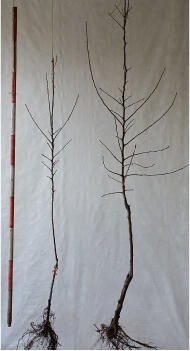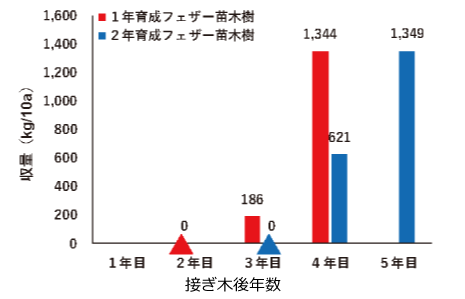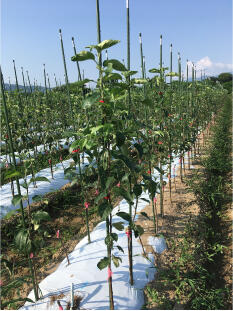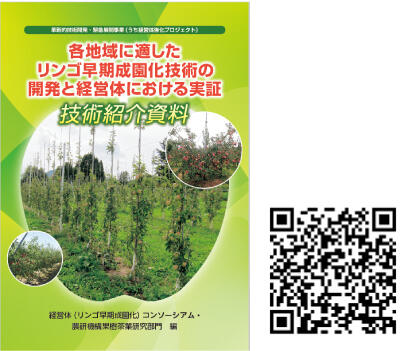(This is an English translation of the original Japanese article.
The publication date refers to that of the Japanese version,
which differs from the upload date of the English version.)
Fruit trees take time to bear fruit after planting, making it crucial to speed up the process of fruiting and reaching the target yield, known as "orchard establishment." In apple cultivation, a technique using "feather seedlings" has been introduced to shorten this period. This involves planting high-density seedlings shaped like bird feathers and training the trees to be small. However, growing feather seedlings takes two years, posing a challenge to increasing their supply. To address this, the Nagano Prefecture Fruit Tree Experiment Station developed a method to grow feathered seedlings in just one year and demonstrated their practicality in high-density cultivation.
What is a feather seedling?
In general dwarf apple orchards, a single rod-shaped seedling is planted and pruned back to promote the growth of fruit-bearing lateral branches. Feather seedlings have already developed these branches during the nursery stage, accelerating fruiting because they are present at planting. Until now, it has taken two years to grow feather seedlings.
Specifically, a scion of apple species such as "Fuji" is grafted onto a dwarfing rootstock to grow a single rod-shaped seedling. Before a bud breaks in the following spring, the seedling is pruned back to 50-60 cm above ground. Only one of the new shoots that emerge from the pruned branch (the original trunk) is left, and as it grows, a benzylaminopurine solution is sprayed to promote the growth of new shoots from the axillary buds (at the base of the leaves) on the new shoot. These new shoots are called feathers. In the following year, or two years after grafting, knip trees with sufficient feathers (see Photo 1, right) can be planted at high density to achieve early establishment of the apple orchard.

Photo 1 : Feather seedlings grown for 1 year (left) and 2 years (right)
(provided by the Nagano Prefecture Fruit Tree Experiment Station)
Shortening feather seedling growing period
Previously, feather seedlings were grown by applying benzylaminopurine solution to new shoots that emerged the year after grafting. However, it has been discovered that applying the solution to shoots that emerge in the same year as grafting can also produce seedlings with feathers equivalent to those grown for two years. High-density cultivation requires a large number of high-quality seedlings that bear fruit early. Halving the cultivation period is a significant contribution to the stable supply of feather seedlings in large quantities. Now in Nagano Prefecture, most of the supplied feather seedlings are 9-month trees. High-density apple cultivation using feather seedlings was originally developed overseas, but the Nagano Prefecture Fruit Tree Experiment Station quickly adopted this technology and has been conducting practical tests for about a decade.
High-density planting cultivation using 9-month trees
The Nagano Prefecture Fruit Tree Experiment Station conducted high-density cultivation for 9-month trees and knip trees of "Shinano Lip " (an early-maturing, prefecture-bred apple variety) and compared their yield and fruit quality.
As a result, the 9-month trees had a harvest of 186 kg per 10a in the third year after grafting, and 1,344 kg in the fourth year, equivalent to that of knip trees in their fifth year (see Figure 1). There was also no difference in fruit quality, such as coloration, sugar content, and acidity.

Figure 1 : Yield trends comparing 9-month trees and knip trees of the new apple variety "Shinano Lip" (provided by the Nagano Prefecture Fruit Tree Experiment Station).
* Permanent planting is carried out in the 2nd year after grafting (red △) for 9-month trees, and in the 3rd year after grafting for knip trees (blue △). No data are available for the 5th year post-grafting of one-year-grown seedlings.
Introduction cost and securing seedlings
About 285 seedling trees per 10a are required for high-density apple cultivation. The price of 9-month trees from a supplier is similar to that of knip trees, but the shorter growing period makes it easier to secure the large number of seedlings needed for high-density cultivation.
Additionally, when producers grow their own seedlings in accordance with the Plant Variety Protection and Seed Act, the shorter growing period reduces labor and costs for pest control, providing significant benefits.
The Nagano Prefecture Fruit Tree Experiment Station is ambitiously working on research for stable production of 9-month trees with consistent quality and development of more efficient rootstock production technology for the future (see Photo 2).

Photo 2 : Raising orchard for 9-month trees
(provided by the Nagano Prefecture Fruit Tree Experiment Station)
Regions for possible introduction
9-month trees can be used outside Nagano Prefecture, especially in areas newly adopting high-density cultivation. However, areas with little snowfall are preferred, as their resistance to snow damage is still unclear. Relatively flat orchards with irrigation facilities are suitable. There are other technologies for early establishment of apple orchards.
The Apple Farm Improvement Consortium(for Early Establishment of Bearing Orchard), organized by public research institutions such as the Yamagata Integrated Agricultural Research Center, and the Institute of Fruit Tree and Tea Science of the National Agriculture and Food Research Organization, have created a pamphlet introducing various technologies for early establishment of apple orchards, including the 9-month tree technology. The title of the pamphlet is "Improvement of Apple Growing Methods Adapted to Each Region for Early Establishment of Bearing Orchard and their on-Farm Trial" (Photo 3 and QR code), and available on their website.

Photo 3 : A pamphlet introducing the technology for early apple orchard establishment
(provided by the National Agriculture and Food Research Organization)
Project name
The special scheme project on vitalizing management entities of agriculture, forestry and fisheries
Project period
FY2017 to 2019
Title
Improvement of Apple Growing Methods Adapted to Each Region for Early Establishment of Bearing Orchard and their on-Farm Trial
Leading research institutes
Institute of Fruit Tree and Tea Science of the National Agriculture and Food Research Organization (NARO) (representative institution), Nagano Prefecture Fruit Tree Experiment Station, Tugaru Hirosaki Japan Agricultural Cooperative, Iwate Agricultural Research Center, Koukaen (Tsuyoshi Takano), Miyagi Prefectural Agriculture and Horticulture Research Center, Akita Fruit-Tree Experiment Station, Horticultural Experiment Station of Yamagata Integrated Agricultural Research Center, Fukushima Agricultural Technology Centre Fruit Tree Research Centre , Tohoku Agricultural Research Center of NARO, Hirosaki University
